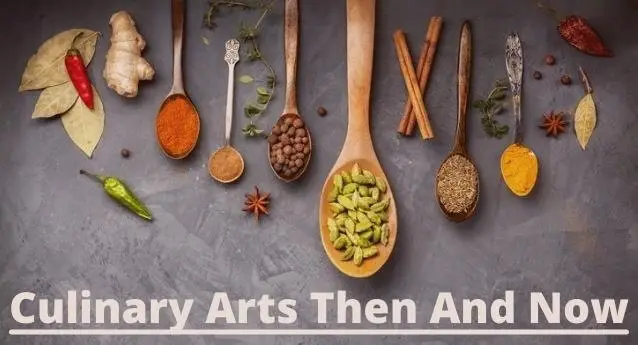Culinary arts involve the preparation, cooking, and presentation of food, which is typically in the form of meals. Individuals employed in this sector – particularly in businesses such as restaurants – are sometimes referred to as “chefs” or “cooks,” although the phrases “culinary artist” and “culinarian” are also used. Table manners, sometimes referred to as “the table arts,” are occasionally referred to as culinary art.
Expert chefs are expected to have a working knowledge of food science, nutrition, and diet and are tasked with creating dishes that are visually appealing as they are on the tongue. Their primary locations of employment, after restaurants, are delicatessens and somewhat large institutions such as hotels and hospitals.
Culinary Arts Then And Now, To Learn About The Transform Change Of Culinary Arts Then And Now, Continue Reading the Content.
Culinary Arts
Culinary arts is the preparation, cooking, and presentation of food, often in the form of meals. Individuals employed in this sector, particularly in places such as restaurants, are frequently referred to as ” chefs ” or ” cooks, ” although the phrases “culinary artist” and “culinarian” are also used. Culinary art is comprised of the preparation, cooking, plating, presentation, and service of food.
It is intended to relate to meals and their constituents, not to sweets or bread. Culinary arts cover a broad spectrum of themes. These areas include food science and nutrition, ingredient quality, seasonality, flavors, textures, and plate styling and color. This large category encompasses many specialties, niches, and job titles.

Culinary Arts Then And Now
Culinary arts were once classified as either qualitative or quantitative but have evolved into a blend of culinary arts and food technology. Instead of a chef, consider a career in Food Science and Technology. Culinary artists have benefited from increased visibility and opportunities as a result of regional, national, and international culinary and cultural festivals. The industry is predicted to grow both qualitatively and quantitatively in the coming years. Inductive in nature when it comes to data collection activities. After that, the work of important writers in the field of internships is compared and contrasted. Let’s have a look at the difference between Culinary Arts Then and Now in the article below.
Culinary Arts Then
Culinary arts are the preparation, cooking, and presentation of food, typically in the form of meals. Chefs or cooks are the most frequently used terminology in this sector, notably in restaurants, while the terms culinary artist and culinarian are also used. Culinary arts are an integral part of American history and culture and a vital and rewarding career worldwide. A culinary arts employment given by the best culinary schools and cooking schools can lead to a career as a professional chef, restaurant manager, or food service manager.
Culinary Arts Now
The quantitative analysis comprises the collection and evaluation of numerical data. Due to the non-numerical nature of the data, it is qualitative. Strategic goal-setting from a quantitative and qualitative perspective data collecting technique analysis of data presentation approach for data sampling techniques for data analysis strategy for showing data sampling research designs They proposed a culinary arts class in cooperation with a school that offered professional certificates that students could pursue as a vocational road to a job in culinary arts or as a means of increasing their creativity and competence. Prepare outcome reports based on the analysis of quantitative and qualitative data. To ascertain their opinions, phenomenological viewpoints are presented, and quantitative data from the 2006 and 2007 cohorts of culinary arts students are evaluated.
Best Faith Weapons in Elden Ring
Bridgerton Season 2 Episode 1: Release Date, According to Your Time zone
Jujutsu Kaisen Chapter 180 Spoiler, Raw Scan, Release Date, Color Page
History of Culinary Arts
Culinary arts evolved with primitive humans approximately 2 million years ago. Numerous theories abound regarding how early humans cooked meat with fire. According to anthropologist Richard Wrangham, author of Catching Fire: How Cooking Made Us Human, early humans sizzled raw flesh over open flames. Another theory is that people first ate roasted meat by accident after discovering that the flesh of a beast killed in a forest fire was more palatable and easier to chew and digest than raw meat.
Culinary techniques advanced with the advent of pottery and stoneware, cattle domestication, and agricultural developments. In early civilizations, professional cooks were mostly employed by monarchs, aristocracy, and priests. The division between professional chefs and peasants cooking for their families resulted in the development of numerous cuisines.
A large portion of culinary arts education in Europe was established by Jean Anthelme Brillat-Savarin, a man notable for his phrase “Tell me what you eat, and I will tell you who you are,” which has since been mistranslated and oversimplified as “You are what you eat.” Other individuals aided in the delineation of the many branches of food science and gastronomy. Increasingly in-depth and precise studies of foods and the culinary arts have resulted in a growing body of knowledge.
In Asia, a similar process resulted in the establishment of a distinct study of culinary arts, which eventually fused with its Western counterpart. There is no longer a clear distinction between Western and Eastern foods in the present global economy. Culinary arts students today are frequently exposed to the cuisines of a variety of various civilizations from around the world.
Culinary arts as a craft and later as an area of study began to grow in the Western world at the end of the Renaissance period. Chefs previously worked in castles, preparing meals for kings and queens and their families, guests, and other castle employees. As monarchical power waned in popularity, chefs relocated to inns and hotels. From here, the craft developed into a discipline.
Prior to the founding of cooking schools, professional chefs acted as mentors to apprentices. In 1879, the Boston Cooking School established the first cooking school in the United States. This institution established standards for cooking techniques and recipes, so establishing the groundwork for succeeding culinary arts schools.
Is Culinary Arts A Part Of Science?
Culinary arts are an art as well as a science. Cooks and chefs can experiment and produce novel and innovative recipes, combinations, and platings by understanding what happens on a chemical or cellular level while cooking. Culinarians are highly skilled artisans who combine science and art to produce something truly unique. While the flavor of food is unquestionably important, the culinary arts utilize all of our senses to create a rich and multidimensional experience.

Tools and techniques
Professional chefs and ordinary cooks alike employ the tools, referred to like cooking or kitchen utensils, which are a vital aspect of the culinary arts. Professionals in the culinary arts frequently refer to these utensils as “batterie de cuisine.” These tools come in a variety of materials and are used in a variety of ways. Cooking tools are composed of a variety of materials, ranging from wood, glass, and various types of metals to the more modern silicone and plastic used in many modern kitchens.
There is a diverse range of cooking techniques within the culinary arts that originate from numerous cultures and continue to evolve over time as they are exchanged between cultures and advanced by new technology. Different cooking techniques necessitate the use of specific utensils, foods, and heat sources to achieve the intended outcome. While a professional kitchen may employ strategies that a home cook would not, such as the use of an expensive professional grill, cooking methods of all types may be found in practically any kitchen throughout contemporary human history.
How Culinary Arts Helps Students?
Students enrolled in culinary arts programmes learn how to prepare and present food. Thus, what is the absolute bare minimum? If you enjoy cooking and are interested in learning how to prepare a variety of cuisines, the Culinary Arts programme may be a good fit. If you’re interested in pursuing a career in the food industry, you may like to enrol in a culinary arts degree programme. In 1929, the American Culinary Federation was created to advance culinary education. Ida McCray studied culinary arts.
Culinary Arts Then And Now-FAQ
Culinary arts involve the preparation, cooking, and presentation of food, which is typically in the form of meals. Individuals who work in this sector – particularly in businesses such as restaurants – are frequently referred to as ” chefs ” or ” cooks, “but the phrases “culinary artist” and “culinarian” are also used.
If this sounds intimidating, keep in mind that culinary arts experts must also be familiar with international cuisines. Culinary arts experts who operate in a hospitality establishment that caters to international customers must be conversant with international dishes and tools.
Having a working knowledge of the culinary language will help you optimize your back-of-the-house operations. Culinary words are not exclusive to chefs. The jargon used in the kitchen serves a purpose: to expedite the process and ensure everyone’s safety. This exhaustive culinary lexicon will put your culinary skills to the test.
Culinary terminology span from methods of food preparation and sauce preparation to kitchen objects and foods themselves. These cooking terminologies are frequently derived from foreign languages such as French and Italian and might be difficult to comprehend.











